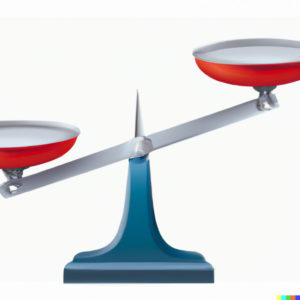Updated on Jan 10th 2020: This has evolved and refined over years. Broadly, the thought and on-hands nature stays the same
Note: Contact me if you want me to run this workshop for your organization.
I have been running these 1-day workshops for IIM’s Entrepreneur Cell, NASSCOM, independent startup groups and various offices of ThoughtWorks. We start with a new idea or an existing idea, work through it over the day, focus on one key product to come up with a clear picture of what it will be and an MVP for it. The audience has been folks who came in just with an idea, startups that came with a prototype or startups that have started seeing some customer traction.
Over time a structure has emerged. This is what I am sharing here. And, this is going to be a long one.
My commentary with use startups who have spent some time on the idea and have a prototype in the market as a typical example. However, this approach work for the whole spectrum I mentioned above.
Here is what a typical agenda looks like:
Agenda
| 9:00 AM | Our Approach, Objectives and Ground Rules | 0:30 |
| 9:30 AM | Product in a Box | 0:30 |
| 10:00 AM | Elevator Pitch | 0:30 |
| 10:30 AM | Business Model Canvas Value Prop., Customer Segments & Channels |
1:00 |
| 11:30 AM | Break | 0:15 |
| 11:45 AM | Business Model Canvas Cost & Revenues |
1:00 |
| 12:45 PM | Lunch Break | 0:45 |
| 1:30 PM | Product Strategy Products line-up & Prioritization |
0:30 |
| 2:00 PM | Product Management Canvas Idea, Market, Customer Segment, Business Value & Metrics |
1:00 |
| 3:00 PM | Break | 0:15 |
| 3:15 PM | Product Management Canvas Features, Evangelism, Go To Market, Visual Identity & Key Resources |
1:00 |
| 4:15 PM | Break | 0:30 |
| 4:45 PM | Identifying MVP
Using Product Management Canvas to identify an MVP |
0:45 |
| 5:30 PM | Done |
The day is run over a very tight schedule. So keeping time is important. Also, the aim is breadth-first and cover all rather than depth-first and iron out details.
This allows the attendees to get familiarity with the methods and they can do a detailed version on their own.
Our Approach, Objectives and Ground Rules
This is similar to Inception. One thing I always bring out that we will be discussing each idea with the team. Folks attending should be comfortable to share their idea with the group.
I always allow mobile phones. Folks are going to be here all day, typically a Saturday. A few minutes of phone calls related to family and work is not very disruptive.
Product in a Box
At times referred to as Product Box[1], it is a fun activity in which everyone is asked to imagine if their product came in a box, what would the label of the box look like. I provide this empty sheet to participants:

In order to help them visualize and organise their thoughts, I show them this slide for reference and walk them through each section and give some examples.
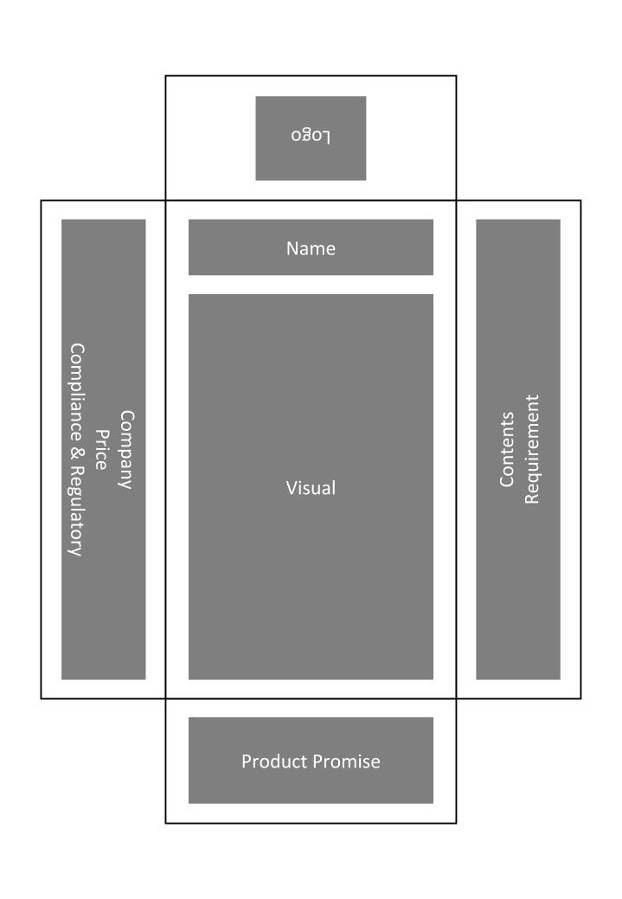
Usually, people struggle a bit with this. Either they will be lost for words or write too much text and are frozen! Also, this being the first session, folks are a bit slow to get started. I suggest to them is to just start writing. Once they do, words follow words and they are able to finish.
Once all are done (15 mins), I request each to read out exactly what they have written and add nothing like an afterthought. I then as all if they will be willing to buy/invest in the idea.
The very exercise of having to write out the thoughts, read them aloud, not add in ad hoc manner to it and then hear responses, sets the time for rest of the day. I stress a lot on brevity and simplicity.
Elevator Pitch
We have a very good format for Elevator Pitch[2] that is part of the Inception Deck. I often reuse that. We give them a printed page which has the outline of an Elevator Pitch that they have to complete. Having gone through the Product in a Box exercise earlier, heard the feedback, folks just go swiftly though this and are able to come up with excellent articulation. The format looks like this:
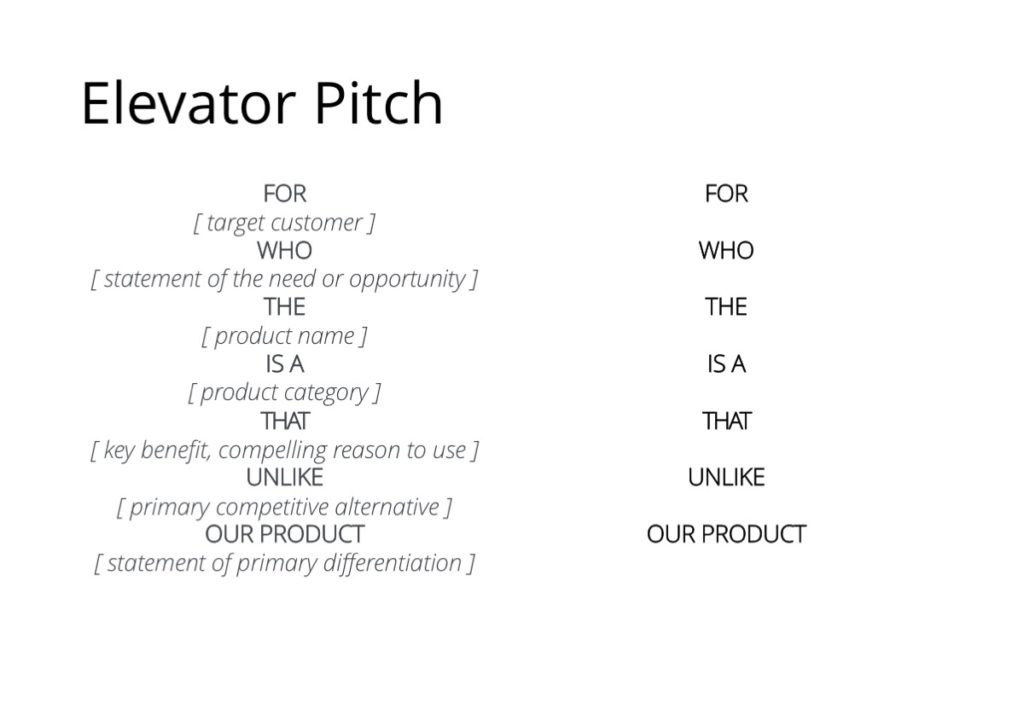
Note: I have reversed the order and done Elevator Pitch first and then the Product in a Box. But in either case, attendees struggle with the first one and then do the next one rather fast and nicely.
Business Model Canvas
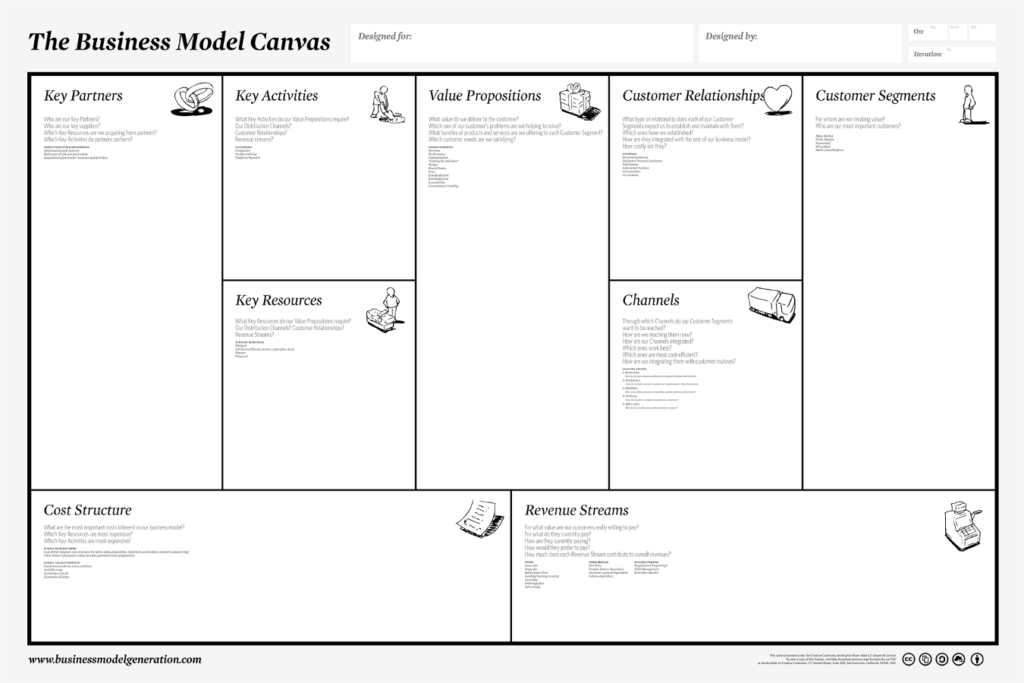
We do Business Model Canvas[3] across two sessions.
Session 1
I first ask them to write down key Value Props. This is followed by writing down the various Customer Segments. The key is to narrow them as much as possible. So using words like ‘All’ are discouraged.
Then I ask them to make a line for each Value Prop to each Customer Segment it serves. Ideally, all Value Props should serve some segment and all segments should have some value prop for them. If none, the customer segment needs to go.
Then I ask them to name a channel for each Value Prop. At least one channel for each stage of Brand Awareness Funnel. That is Awareness, Consideration, Engagement and then Purchase. In my previous life, my work on Brand Awareness Funnel was converted into a patent by my then organization.
Session 2
In this session, we focus on Cost and Revenue. Surprisingly, helping startups that been around, to realize their cost is the most a-ha / oh-sh*t moment. Perpetual optimists like Founders rarely internalize the cost of getting things done and this serves as a good eye-opener. Lots of time is spent on the revenue side of things.
I usually help them with quick back-of-envelop calculations. Salaries of founders, office rent, internet bills, laptops, furniture, folks for sales, support, development, CA, filings, buying compute power, licenses, fees, etc and soon the estimates balloon.
Session on revenue is smaller. I ask them to write down all possible avenues of revenues and then estimate revenues it can bring in over the time and the complexity of making that revenue. This helps them prioritize one avenue over another.
Product Strategy
This session was added after 2-3 such workshops. When asked what all products does your company build, what is your key product, what all components does your product have or what all products are you working on to enable your key product, I used to get very vague answers. Most of them would start talking about their awesome app.
The thing is, that without realising how much effort the company is putting into various products (in house, customer-facing, partner-facing, admin tools, 3rd part integrations, that 3rd Parties can use, etc), it was often apparent that they were not looking at the whole picture when prioritising.
So I came with this Product Stack[4] template:
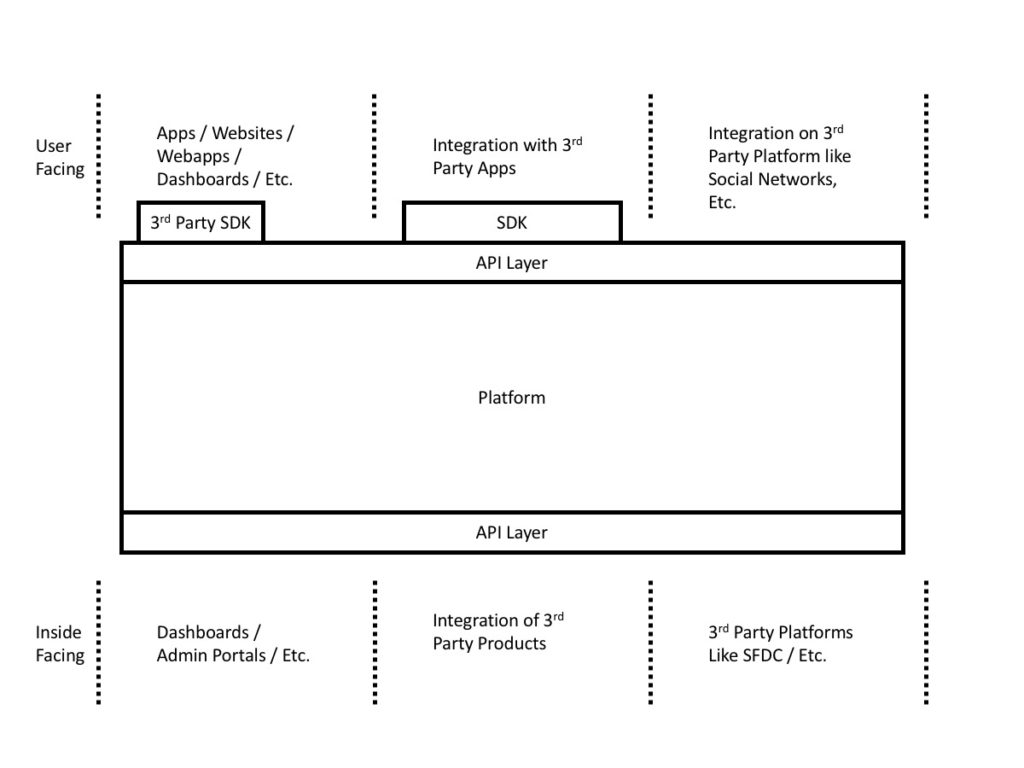
I ask them to fill this up with all things they are using and have built. The output surprises everyone. Once they have listed them all, I ask them to mark out ones without which they can not proceed as a business. This eliminates lots of random / legacy products they have accumulated over time and focus on ones that really matter.
There are two things that also happen while we do this exercise:
1. We force them to think beyond Channels (like Apps, Websites, etc) and think in terms of the whole Platform.
2. Get them into an exercise of prioritizing engineering output and not jump into creating apps, websites, etc without creating a roadmap at a strategic level.
Note: In case of new ideas, I ask them to list down things they will need to use and build. They then prioritise based on that.
Product Management Canvas
Once the key product has been reinforced, identified or agreed up, we use the Product Management Canvas[5] to describe it.
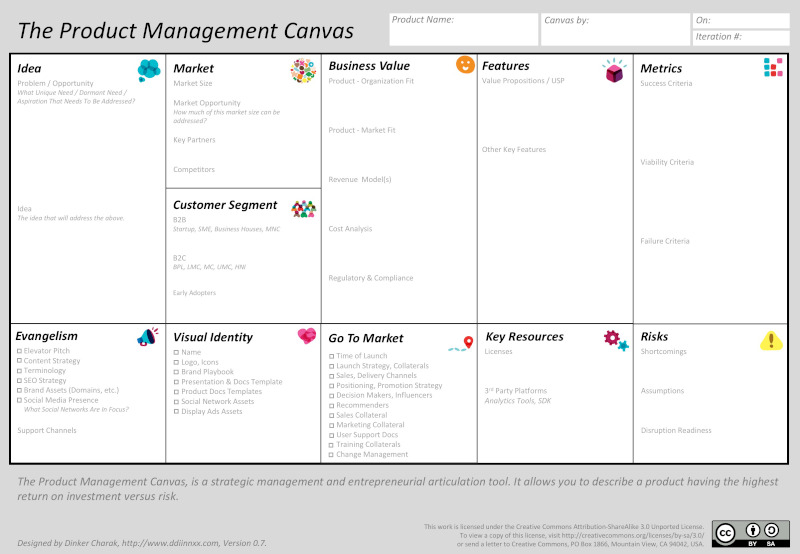
Lots of content flows in from the canvases and work done in previous sessions. That makes filling up this canvas faster. Only thing is that these are not at the level of entire business but at the level of this product. This means the slice of whole business canvas that this product addresses.
We recommend they do it for each of their key product. Product Managers can use it for their products. More about Product Management Canvas here.
Identifying MVP
One thing that the Product Management Canvas helps with is identifying an MVP. Here is how I put it:
“Specific Features that deliver extreme value to a specific Customer Segment and helps attain specific Business Value using specific Key Resources measured using related Success and Failure Metrics with right Visual Identity and Go-To-Market support.”
The Product Management Canvas helps identify that MVP that should be rolled out first.
Preparation for the Workshop
As preparation, I printout some canvases. Here are the list and size of the paper on which they are printed.
| Product In A Box | A4 |
| Elevator Pitch | A4 |
| Business Model Canvas | A3 |
| Product Management Canvas | A3 |
Using A3 gives some real-estate to write down on the Business Model Canvas and the Product Model Canvas.
Never Alone
These sessions were not always done alone. I want to acknowledge these fellow ThougthWorkers for contributing in various sessions I held: Nagarjun Kandukuru, Shaun Jayaraj, Sachin Sapre, Sharath Satish, Suganth Chellamuthu, Kiran M, Prasanna J Vaste and Arjun Dev.
Experience Report
Here are some blogs on my experience of running these sessions over years:
References
[1] Know more about Product in a Box in Innovation Games by Luke Hohmann.[2] Know more about the Elevator Pitch format on Jonathan’s blog.
[3] Business Model Generation by Alexander Osterwalder, Yves Pigneur (https://strategyzer.com/)
[4] & [5] Created by the Dinker Charak and can be shared under Creative Commons (CC BY-SA 3.0)
